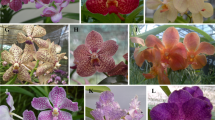Abstract
Before approaching anther culture as a tool to trigger an androgenic response in a new species, it is advisable to characterize and correlate flower and male gametophyte development to enable reproducible identification of the appropriate starting material. Buds and flowers of Opuntia ficus-indica cv. Gialla were classified in eight stages according to their total length at the earlier stages and the length of the corolla in flowers with emerging sepals. Due to the low condensation of chromatin in the microspore nucleus as well as in the vegetative nucleus of the bi- and tricellular pollen along with the high autofluorescence of the intricate exine, DAPI staining turned out not to be feasible in this species. Therefore an approach based on light-microscopy observation of semithin sections was used. These sections were stained with toluidine blue for general structure recognition and I2KI to study starch deposition. Correlations were made between the sequential floral and male gametophyte development. Using this approach we determined the timing of pollen formation and observed that pollen development is impaired in plants producing seedless fruits. Furthermore, anther culture was carried out with anthers collected from flower buds at stages 2 and 3. Most of the anthers produced callus, however no regeneration was obtained.
Similar content being viewed by others
References
Bárány I., González-Melendi P., Fadón B., Mitykó J., Risueño M.C., Testillano P.S. 2005. Microspore-derived embryogenesis in Capsicum annuum L.: subcellular rearrangements through development. Biol. Cell 97: 709–722.
Coronado M.J., González-Melendi P., Seguí J.M., Ramírez C., Bárány I., Testillano, P.S., Risueño M.C. 2002. MAPKs entry into the nucleus at specific interchromatin domains in plant differentiation and proliferation processes. J. Struct. Biol. 140: 200–213
Chessa I., Nieddu G. 2002. Investigations on variability in the genus Opuntia as fruit crop for genetic improvement. Acta Horticult. 575: 345–353.
Chessa I., Russu C., Nieddu G., 2000. Embrionia nucellare ed allevamento dell’embrione zigotico in Opuntia ficus-indica (Mill.). Atti IV Congresso Nazionale su Biodiversità “Germoplasma locale e sua valorizzazione”, II: 649–652.
Germanà M. A., Chiancone B. 2003. Improvement of the anther culture protocol in Citrus clementina Hort. ex Tan. Plant Cell Rep. 22: 181–187.
González-Melendi P., Testillano P.S., Ahmadian P., Reyes J., Risueño M.C. 2000. Immunoelectron microscopy of PCNA as an efficient marker for studying replication times and sites during pollen development. Chromosoma 109: 397–409
González-Melendi P., Shaw P. 2002. 3D gold in situ labelling in the EM. Plant J. 29: 237–243
González-Melendi, P., Ramírez, C., Kumlehn, J., Testillano, P.S., Risueño M.C. 2005. 3D confocal and electron microscopy imaging define the dynamics and mechanisms of diploidisation at early stages of barley microspore-derived embryogenesis. Planta 222: 47–57
Heberle-Bors E. 1985. In vitro haploid formation from pollen: a critical review. Theor. Appl. Genet. 71: 361–374
Llamoca-Zarate R. M., Studart-Guimar es C., Landsmann J., Campos F.A.P. 1999. Establishment of callus and cell suspension cultures of Opuntia ficus-indica. Plant Cell Tiss. Org. Cult. 58: 155–157.
O’Brien T. P., McCully M. E. 1981. The study of plant structure. Principles and selected methods. Termarcarphi, Wantirna, Victoria, Australia.
Pinheiro da Costa S., Soares, A. A., Arnholdt-Schmitt B. 2001. Studies on the Induction of Embryogenic Globular Structures in Opuntia ficus-indica. JPACD 4: 66–74.
Ramírez C., Chiancone B., Testillano P. S., García-Fojeda B., Germaná M. A., Risueño M. C. 2003. First embryogenic stages of Citrus microspore-derived embryos. Acta Biol. Cracov. Bot. 45/1: 53–58
Reynolds A. G., Arias E. 2001. Introduction. In: Cactus (Opuntia spp.) as forage. FAO Plant Production and Protection Paper, 169: 1–2.
Risueño M. C., Medina F. J. 1986. The nucleolar structure in plant cells. Cell Biol. Rev. 7: 1–140
Testillano P. S., González-Melendi P., Coronado M.J., Seguí J. M., Moreno-Risueño M. A., Risueño M. C. 2005. Differentiating plant cells switched to proliferation remodel the functional organization of nuclear domains. Cytogenet. Genome Res. 109: 166–174
Touraev A., Vicente O., Heberle-Bors E. 1997. Initiation of microspore embryogenesis by stress. Trends Plant Sci. 2: 297–302
Vergne P., Delvallee I., Dumas C. 1987. Rapid assessment of microspore and pollen development stage in wheat and maize using DAPI and membrane permeabilization. Stain Technol. 72: 299–304.
Weiss J., Nerd A., Mizrahi Y. 1993. Vegetative parthenocarpy in the cactus pear (Opuntia ficus-indica (L.) Mill.). Ann. Bot. 72: 521–526.
Author information
Authors and Affiliations
Corresponding author
Rights and permissions
About this article
Cite this article
González-Melendi, P., Germanà, M.A., Guarda, N.L. et al. Correlation of sequential floral and male gametophyte development and preliminary results on anther culture in Opuntia ficus-indica . Acta Physiol Plant 27, 687–694 (2005). https://doi.org/10.1007/s11738-005-0072-9
Accepted:
Issue Date:
DOI: https://doi.org/10.1007/s11738-005-0072-9




